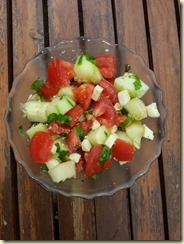| |
 |
Archive for Diabetes
August 20, 2014 at 8:49 am
· Filed under Diabetes, General Nutrition & Wellness, Nutrition, Recipes, Wellness
One of our favorite summer-time salads! Very fast to throw together for lunch or as side-dish with a grilled dinner.

Ingredients:
2 medium tomatoes, chopped
1 medium cucumber (peeled, if desired)
5-6 basil leaves, chopped
2 ounces part-skim mozzarella cheese, cut into bite size chunks
1 T olive oil
1 T red wine vinegar
2 t Italian Blend Mrs. Dash (if desired)
Directions:
Mix the tomatoes, cucumbers, basil and cheese together into two individual serving bowls. Top each salad with 1/2 T olive oil, 1/2 T vinegar and 1t Italian seasoning to each bowl. Makes 2 servings.
Nutrition Facts
1 Serving:
Calories –187.1
 Total Fat – 11.3 g Total Fat – 11.3 g
 Saturated Fat – 3.8 g Saturated Fat – 3.8 g
Polyunsaturated Fat – 0.7 g
Monounsaturated Fat – 6.3 g
 Cholesterol – 16.4 mg Cholesterol – 16.4 mg
Sodium – 151.3 mg
 Potassium – 58.3 mg Potassium – 58.3 mg
Total Carbohydrate – 12.0 g
Dietary Fiber – 3.2 g
Sugars – 8.0 g
 Protein – 10.0 g Protein – 10.0 g
It’s Your Health. It’s Your Life. Make That Change!

Permalink
November 28, 2013 at 7:43 am
· Filed under Diabetes, General Nutrition & Wellness, Wellness

We wanted to wish everybody a Happy, Healthy and Safe Thanksgiving! This is the kickoff to the Holiday Season and as a person with Type 1 Diabetes, I am frequently asked how I handle eating during this time of year and still control my blood sugars. My approach is simple. First, I maintain my exercise program! Exercise is part of the blood sugar control program. Second, I never say or let it be said, that I cannot have a certain food. I do not forbid myself from eating anything. I do continue to watch portion sizes and keep track of the amount of carbohydrate that I have eaten. And, I check my blood sugars more often to help me identify how my body is reacting to the foods I’ve had. Checking blood sugars allows me to better dose my insulin and maintain control. Most importantly, I try to shift the focus from the foods to the people. To me Thanksgiving is about sharing memories about the past year and looking toward the future. Cherish the time with one another and enjoy the love, laughter and warmth the Holidays can bring.
It’s Your Health. It’s Your Life. Make That Change!
~ John
Permalink
November 5, 2013 at 12:58 pm
· Filed under Diabetes, Wellness
Welcome to November! This is the month of giving thanks and preparing for the Christmas Holiday. It is also a time of reflection as the year draws to a close. November is also National Diabetes Awareness Month. There are many great causes happening this month to highlight the need for better Diabetes education and the importance of maintaining continued research in looking for a cure. The JDRF, what used to be called the Juvenile Diabetes Research Foundation, is a leader in raising funds and awareness of how to improve treatment options for those with Type 1 Diabetes. While that cause is truly noble, I write today not of raising money but of raising awareness that YOU hold the keys to better health.
I have been living with Type 1 Diabetes since Aug ust of 1991. Um, that’s over 22 years! Actually, that’s about 8120 days, or 194,880 hours of living, breathing and thriving with Diabetes. Those 22 years have resulted in over 40,600 blood glucose checks, and more than 32,480 insulin injections. That’s a lot of poking and sticking going on. I’ve been through more than 15 different blood glucose monitors, have gone from using pork insulin and drawing up into a syringe, mixing and making sure each insulin dose is correct to using more synthetic versions of insulin that are “cleaner” and don’t cause insulin site reactions. Today’s insulin now comes in a convenient “pen” that only requires attaching a needle to it to allow for injection. The insulin pumps, that many with Diabetes use, continue to decrease in size and improve accuracy and titration of insulin to better meet the needs of the person with Diabetes. ust of 1991. Um, that’s over 22 years! Actually, that’s about 8120 days, or 194,880 hours of living, breathing and thriving with Diabetes. Those 22 years have resulted in over 40,600 blood glucose checks, and more than 32,480 insulin injections. That’s a lot of poking and sticking going on. I’ve been through more than 15 different blood glucose monitors, have gone from using pork insulin and drawing up into a syringe, mixing and making sure each insulin dose is correct to using more synthetic versions of insulin that are “cleaner” and don’t cause insulin site reactions. Today’s insulin now comes in a convenient “pen” that only requires attaching a needle to it to allow for injection. The insulin pumps, that many with Diabetes use, continue to decrease in size and improve accuracy and titration of insulin to better meet the needs of the person with Diabetes.
I still wake up every morning wondering what this day with Diabetes will hold but I am always thankful for the opportunity to share another day with my family and my friends. While having Diabetes never gets easy, living with Diabetes is very manageable. Treatment guidelines and management goals can be individualized for each person attempting to gain better control. Successful Diabetes management requires focus, commitment and sacrifice, not just for the individual diagnosed with it but also from the family and friends of that individual.
I do hope a cure for Type 1 Diabetes is found. But I am not asking you for money to support that cause. I am asking you to take control of your health now. Stop making excuses as to why you can’t eat right or exercise or visit the doctor. You are much more powerful than you realize! Step up and take  the challenge to change your life. We don’t have to have complex algorithms to achieve this. Start with one small step. Be it recruiting friends to walk with you each day or eating at least 1 piece of fruit everyday. Remember, there is no finish line in this race. This is a long journey that will change and evolve as we change and evolve. We have to allow ourselves the opportunity to completely mess things up but we must also keep our eyes on our goals. We have to keep a positive outlook! the challenge to change your life. We don’t have to have complex algorithms to achieve this. Start with one small step. Be it recruiting friends to walk with you each day or eating at least 1 piece of fruit everyday. Remember, there is no finish line in this race. This is a long journey that will change and evolve as we change and evolve. We have to allow ourselves the opportunity to completely mess things up but we must also keep our eyes on our goals. We have to keep a positive outlook!
So, if you have Diabetes, whether Type 1, Type 2 or Gestational or have Pre-Diabetes, take the opportunity to learn more. Seek out the counsel of Certified Diabetes Educators. Become an active participant in your own health care. We don’t need a health care reform act from the government to help us become healthier. We need to reform ourselves and our way of thinking. We can do this!
It’s Your Health. It’s Your Life. Make That Change!
~John
Permalink
January 1, 2013 at 9:00 am
· Filed under Diabetes, General Nutrition & Wellness, Nutrition, Professional Interest, Wellness

It is here! Time to ring in the New Year. Our kids have been asking us why there are so many TV commercials and radio ads touting the latest diet plans. Because, it’s here! Time to lose the holiday weight! Members of our local Y have been discussing how busy it will be for the next 2 months as everybody tries to restart their New Year Resolutions. It’s here!
Make this year your year! If you plan to start a new exercise program or meal plan, truly set up a plan. You must plan for success. The problem that’s universally noted with our resolutions to start each year is that they are short-lived. This year, launch your resolution with a contingency plan. Plan for barriers and for methods on how you will overcome those barriers. You know life will throw you a curve that could sabotage your plans. You may have already experienced this in the past. So get ready for it. How do we do that?
1. Make yourself accountable. Write down your goals and how you will go after them. Simply saying you want to lose weight by exercising more may not get it done. Instead, pick the days of the week and times that will fit your schedule. Set up an exercise routine. Schedule it on your calendar just as you would any other important task or appointment. AND, set up a back up plan just in case your first choices don’t work or life happens and you can’t exercise that day or time.
2. Set goals that you can reach but will also challenge you. Setting goals too difficult to reach may set you up for failure. Setting goals too easy to reach will not force you to change. If you have never cooked before, are you going to be able to set a cooking goal to improve your diet? Evaluate your diet, or schedule an appointment with a Registered Dietitian to get some ideas on what you may need to change to better meet those meal planning goals. For instance, you may only need to add a piece of fruit to your meals everyday. Sounds easy but if you are not into eating fruit, you may find it difficult. Pick a fruit, make sure you have enough on hand and plan the meals to which it will be added.
3. Regularly evaluate your progress. If something’s not working the way you want it to, change it up and try a new approach. Don’t give up on it. Businesses follow this model routinely. The Plan-Do-Check-Act set allows them to evaluate their goals and see how it is moving along. It’s not an all or nothing approach. Remember, “If you always do what you’ve always done, you’ll always get what you always got!” . Change is about trying new things. In effect, we are experimenting with ourselves. We have the rest of our lives to integrate changes. It doesn’t have to be today!
4. Stay Positive! Our wish for each of you is to be able to experience what successful change is all about.  One of the best ways to do that is to keep an upbeat approach. We know that we are not living in an overly optimistic time period right now. With the problems we face on a day to day basis, it can make it hard to find the good that life has to offer. One of our favorite quotes, which is credited to Patricia Neal, addresses this: “A strong positive mental attitude will create more miracles than any wonder drug.” Life will bring us good days and bad, sunshine and rain, laughter and tears. We can’t always control the happenings in life but we can control how we react to them. Smile often and make that part of your daily routine! No matter how bad off we feel or think we have it, there is always somebody else out there worse off than us. We all need to extend our hands and our hearts to help others! One of the best ways to do that is to keep an upbeat approach. We know that we are not living in an overly optimistic time period right now. With the problems we face on a day to day basis, it can make it hard to find the good that life has to offer. One of our favorite quotes, which is credited to Patricia Neal, addresses this: “A strong positive mental attitude will create more miracles than any wonder drug.” Life will bring us good days and bad, sunshine and rain, laughter and tears. We can’t always control the happenings in life but we can control how we react to them. Smile often and make that part of your daily routine! No matter how bad off we feel or think we have it, there is always somebody else out there worse off than us. We all need to extend our hands and our hearts to help others!
We want to wish you all a very Happy and Healthy New Year! This is your year to shine. Don’t let anything stand in your way!
~It’s Your Health. It’s Your Life. Make That Change!
~Angie & John
Permalink
November 21, 2012 at 11:06 am
· Filed under Diabetes, General Nutrition & Wellness, Nutrition, Wellness

Brussels sprouts are one of the most hated foods out there. In all our years of experience as RD’s, it has come up as the absolute top food that our clients avoid. Why? Well, they do have a strong flavor and the house really gets smelly when you cook them. Also, memories may go back to childhood when the sprouts may have simply been boiled and placed in front of you with instructions to finish them before you could leave the table.
Our suggestion– try them again. Erase those bad memories and approach them with a beginner’s mind. They are incredibly good for you—high in Vitamins A & C, folic acid and fiber. Also, they are cruciferous vegetables. Cruciferous is a Latin word meaning “cross-bearing" from the shape of their flowers, whose four petals resemble a cross. (Cool!) Curciferous vegetables include cauliflower, cabbage, bok choy and broccoli. Research indicates that these vegetables have anti-cancer properties.
Here is a simple, delicious recipe that we prepared for the first time this week & served to the HELP PD (Prevent Diabetes) study group. They all raved over them-some members had never even tasted them before. Our kids really liked them as well-their plates were empty! Let us know what you think of this recipe. Happy Thanksgiving to you all!
It’s Your Health. It’s Your Life. Make That Change!
~ Angie & John
Brussels Sprouts with Balsamic Vinegar Sauce
- Preparation time: 10 minutes
- Serves: 6
Ingredients:
· 1-1/2 pounds fresh Brussels sprouts
· 2 cloves garlic, peeled and sliced
· 1 medium yellow onion, peeled & sliced
· 2 tablespoons olive oil
· 1/4 cup balsamic vinegar
· dash salt
· 1 teaspoon freshly ground black pepper
· 2 tablespoons tub margarine
Directions:
· Trim off the stems and remove any limp leaves from the sprouts
· Blanch sprouts in boiling water w/top for 5 minutes
· Drain and rinse under cold water to stop cooking
· Heat a large frying pan and add the olive oil, garlic and onion
· Sauté until the onion becomes tender
· Add the blanched & drained sprouts.
· Sauté a few minutes until the sprouts are cooked to your liking
· Add the vinegar and toss so that all the sprouts are coated
· Add the tub margarine, salt and pepper and toss together
Nutrition Facts per Serving:
Calories: 136
Fat: 8 gm
Saturated Fat: 1 gm
Carbohydrate: 13 gm
Protein: 4 gm
Fiber: 5 gm
Sodium: 109 mg
Permalink
November 14, 2012 at 8:24 pm
· Filed under Diabetes, General Nutrition & Wellness, Wellness

Today is World Diabetes Day. Millions of people around the world have united to help bring awareness to this chronic disease that affects 371 million people (half of which are undiagnosed). This past August, I celebrated my 21st year of living with Diabetes. That’s right, Celebrated! I’m excited to have accomplished all that I have because of Diabetes. Is being diagnosed with Diabetes hard? Yeah, sometimes. But life, in general, is hard at times. Barriers are barriers only if we let them be. We hold the keys to our own happiness and health. We can’t control others or control all events in our life BUT, we can control how we respond to those events. Every challenge and difficulty we face gives us the opportunity to find out more about ourselves and to discover new ways to succeed.
I have always maintained that had I not been diagnosed with diabetes, I would not be where I am today. Diabetes changed my life in an overall positive direction. Because of diabetes, I discovered new interests, new careers, new friends and a renewed purpose. Because of diabetes, I met the woman that would become my wife and mother of our children. Because of diabetes, I am a better person. To me, diabetes is cool. Yes, having diabetes still sucks, but you cope. Sure it makes me different when comparing me to my peers, but when working with clients that have diabetes, it gives us something in common. I know I may have viewed it differently had I been diagnosed with diabetes while still a child. But for me, the diagnosis of diabetes saved my life!!!
"When one door of happiness closes, another opens; but often we look so long at the closed door that we do not see the one which has been opened for us." -Helen Keller
For more information about World Diabetes Day, visit: http://www.idf.org/worlddiabetesday
~ John
It’s Your Health! It’s Your Life! Make That Change!
Permalink
October 8, 2012 at 10:46 am
· Filed under , Diabetes, General Nutrition & Wellness, Nutrition, Wellness

A recent study published in the Journal of Nutrition Education and Behavior showed that those with Type 2 Diabetes who attended hands-on cooking classes improved the quality of their diets. The study examined 117 people from various ethnic and socioeconomic backgrounds with Type 2 Diabetes who participated in a cooking program.
This program, which was put on by the New Mexico Cooperative Extension and New Mexico Department of Health along with local Certified Diabetes Educators and Registered Dietitians, used elements of social cognitive theory such as self-efficacy, cognitive restructuring, social support and goal setting. The participants learned how to cook, monitor portion sizes, improve the palatability of healthful foods and set personal nutrition goals.
Those with Type 2 Diabetes are encouraged to adopt the nutrition goals of the American Diabetes Association that include limiting intake of total calories, carbohydrate, saturated fat, cholesterol and sodium while increasing intake of vegetables, fruit, whole grains, legumes and fiber. These recommendations are intended to help stabilize blood sugar levels and reduce the risk of heart disease and hypertension.
The researchers for this study had the participants keep a three-day food record before and after the cooking program. They observed statistically significant decreases in calories, total fat, saturated fat, carbohydrates, cholesterol and sodium.
The results of this study bring light to the benefits of cooking meals at home. We don’t necessarily have to attend cooking classes to receive these health benefits. Getting in the habit of planning meals in advance, grocery shopping efficiently and preparing the majority of meals at home can go a long way to preserving our health.
It’s Your Health. It’s Your Life. Make that Change!
~ Angie
Permalink
July 25, 2012 at 8:55 am
· Filed under , Diabetes, General Nutrition & Wellness, Nutrition, Wellness

In a recent study published in the Journal of Clinical Endocrinology and Metabolism, researchers found that a low-fiber diet can be harmful to the health of teenagers. The study, which included 559 teenagers in Georgia, looked at how fiber intake was related to certain inflammatory-related biomarkers. A high level of these biomarkers is increased in obesity and can result in systemic inflammation, which is a risk factor for heart disease and diabetes.
Previous studies have shown that fiber can dampen the inflammatory response, and adolescents in the United States tend to fall far short on meeting the recommended intake of fiber. The teenagers in this study were no exception: they consumed 66% less than the recommended intake for their age group. The study results showed that as fiber intake went down and other factors were controlled, the levels of visceral fat increased, as did plasma C-reactive protein and plasma fibrinogen—associated with the inflammatory response and coronary disease, respectively. According to the study, fiber intake may affect visceral fat levels due to “1) increased fecal bulk and less transit time, thus allowing less time for digestion and absorption of nutrients; 2) increased insulin sensitivity; and 3) increased intakes of phytoestrogens (i.e. isoflavones and lignans) that are generally found in foods high in fiber such as fruits and vegetables.”
Women should consume 25 grams per day of fiber, while men should aim for 38 grams. How can you get more in your diet?
- Add a half-cup of berries to your breakfast cereal or oatmeal (4 grams)
- Substitute one cup of bulgur (8 grams) for white rice
- Include an apple and an orange with lunch (9 grams)
- Choose three cups of plain popcorn as an afternoon snack (3.5 grams)
- Have a half-cup of black beans in a salad (7.5 grams)
- Mix a high-fiber breakfast cereal (with at least 5 g fiber/serving) with your regular brand (Fiber One Cereal has 14 g fiber/serving)
- Look for “100% whole wheat” or whole-grain bread, with 2- 3 g fiber per slice
- Use “Old Fashioned Oatmeal” instead of instant~ mix in fruit to add even more fiber
- Opt for brown rice~ It has five times more fiber than white rice!
- Instead of drinking the juice, eat the whole, fresh fruit
- Eat the skins of potatoes and other fruits and veggies
- Serve hummus, made from chickpeas, instead of sour-cream dips
- Instead of iceberg lettuce, choose romaine or spinach for salads
- Pack healthy snacks for the road, or for work– baby carrots, cucumber slices, mushrooms, or bell peppers make great snacks!
It’s Your Health! It’s Your Life! Make That Change!
~ Angie
Permalink
July 9, 2012 at 3:25 pm
· Filed under , Diabetes, General Nutrition & Wellness, Wellness

Current estimates from the Centers for Disease Control and Prevention say that nearly 80 million Americans have prediabetes, as indicated by a fasting blood glucose level between 100 and 125 mg/dL. According to the American Diabetes Association, up to 70% of those will at some point see their condition progress to type 2 diabetes. However, research recently published in The Lancet found that people with prediabetes who got their glucose levels back to normal, even briefly, were 56% less likely to develop type 2 diabetes later in life.
Weight loss and intensive lifestyle changes were among the factors related to reductions in blood glucose levels. The study participants who were able to lower their glucose levels back to normal attended more sessions regarding lifestyle sessions than did those who remained with prediabetes. This falls in line with previous findings, including research published in the New England Journal of Medicine in 2001. The members of the intervention group in that study, who all had prediabetes and received individual counseling for weight loss and diet changes, had a 58% reduction in their diabetes risk.
It is a good idea to be tested for Pre-diabetes if you are over 45 years of age and overweight, have high blood pressure, have low HDL and high triglycerides, have a family history of diabetes, have a history of gestational diabetes and/or if you belong to an ethnic group at high risk for diabetes (African Americans, Mexican Americans, American Indians, native Hawaiians and some Asian Americans). Those who have been diagnosed should focus on losing at least five to ten percent of their body weight through increased physical activity and intake of more fruits, vegetables, whole grains, lean proteins and healthyfats.
~Angie
It’s Your Health. It’s Your Life. Make That Change!
Permalink
April 23, 2012 at 12:13 pm
· Filed under Diabetes, diabetes dogs, General Nutrition & Wellness, Professional Interest

Sharing a really cool article from the Virginian-Pilot….
http://hamptonroads.com/2012/04/dogs-help-bring-comfort-regions-hospitals
Dan Warren, President of Guardian Angel Service Dogs will be partnering with the University of Virginia this fall to research the impact that dogs have on improving blood glucose levels in people who have diabetes. It is hoped that the results will help bring about insurance coverage for people with diabetes who may be in need of diabetes alert dogs.
~ Angie
подаръци
Permalink
� Previous entries Next Page » Next Page »
|
 |
|
|
![]() Total Fat – 11.3 g
Total Fat – 11.3 gSaturated Fat – 3.8 g
![]() Cholesterol – 16.4 mg
Cholesterol – 16.4 mg![]() Potassium – 58.3 mg
Potassium – 58.3 mg![]() Protein – 10.0 g
Protein – 10.0 g![]()














